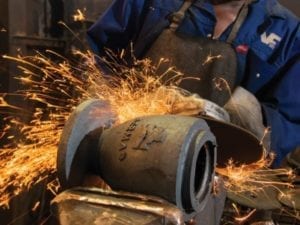South Africa continues to lose millions of litres of water every year due to pipe leaks and bursts. Pressure management is one of the most important interventions that should be considered when attempting to drive down water losses.
The common factor in every water system is the fact that leakage is driven by pressure. Reduce the pressure, even for a short period, and you reduce water leakage, explains Rowan Blomquist, CEO, Macsteel Fluid Control. Possibly one of the simplest solutions in this regard is the use of pressure-reducing valves (PRVs). These offer a way to easily and cost-effectively control the maximum pressure entering a zone. As the local supplier for Bermad products, Macsteel Fluid Control offers a range of PRVs that can help utilities to protect their water supply.Case study: Monterrey
Monterrey is one of the largest cities in Mexico, and its rapid economic and population growth has continuously stressed the water distribution networks. With the goal of becoming Monterrey’s top water provider, the Servicios de Agua y Drenaje de Monterrey (SADM) water utility turned to Bermad Mexico to help improve its ability to maintain the minimum water pressure while reducing leakages and pipe bursts. Having experienced significant growth over the past 50 to 60 years, the city has repeatedly faced the threat of insufficient water supplies. At one time, the city relied entirely on wells located in and near the urban area. However, with the current population of almost five million people, the city has had to develop new sources of water and now relies on surface water for about 60% of its water supply. At the same time, its watershed ranks as one of the poorest in the world, with a per capita water use of just 290 ℓ per day per person – compared to a significantly higher global average of 3 795 ℓ. In the late 1990s, in an effort to proactively address its water supply problems, Monterrey began implementing district metering areas (DMAs) designed to serve clusters of about 300 to 400 customers. Now, with more than 3 300 DMAs, the city is able to monitor flows within much smaller areas, facilitating better leak detection and location. In 2014, the city estimated that less than 6% of the water entering the distribution system was lost to leakage. However, given its vulnerability to water shortages in the face of continued growth, the city continues to look for ways to mitigate water loss within its distribution system. Leakages and frequent bursts in distribution lines continue to be a problem in Monterrey, primarily due to the lack of adequate pressure regulation. In addition to the costs associated with non-revenue water, fixing burst and leaking pipes is a time-consuming and expensive process.During times of peak demand, the pressure in Monterrey’s pipes is generally offset by water withdrawals. However, without a change in pressure to adjust for lower consumption at night, the pressure in its distribution system increased, causing leakage and pipe bursts. Monterrey needed a cost-effective way to reduce the average pressure during non-peak hours.
The Bermad solution
The solution to Monterrey’s problem was to install PRVs at strategic points in the system to manage the pressure. This allowed the minimum critical pressure to be dropped at low-demand times, such as in the afternoon or at night. The utility conducted a hydraulic analysis and reviewed the sectorisation of the entire system to determine where the new valves would have the greatest impact. Then, in addition to providing the necessary valves, Bermad provided training to utility staff to help them bring the valves online and teach them how to properly calibrate and operate them. In Monterrey, Bermad recommended the 7PM Flow Compensated PRV – a hydraulically operated, diaphragm-actuated water PRV that automatically optimises downstream pressure according to the water demand. This model offers many advantages, including operational cost savings and reliability because it does not rely on electrical power. It is also serviceable in-line and easy to install, requiring no additional pipeline accessories. The 7PM’s double-chambered design allows for moderated valve reaction, which provides better protection for the valve diaphragm and system piping. Furthermore, the valve features a V-port throttling plug to provide a more accurate, stable and smoother response during pressure and flow regulation – particularly at low flow – while reducing noise and vibration, and increasing valve travel to optimise performance.The results
SADM installed 16 of Bermad’s 7PM water pressure management valves over a period of six months. Before the installation, the pressure was roughly 7 bar to 8 bar, with a consumption rate of 27 ℓ/s. Now, during non-peak hours, the valve automatically triggers a lower-pressure regime to help avoid leakage and burst frequency. The average pressures have since fallen to within 1.7 bar to 2.9 bar, and the minimum flow range reduced by 50%, while the maximum flow was reducedby 15%. With a better-regulated system, SADM experiences fewer pipe bursts, resulting in reduced repair costs and water savings. In addition to reducing leakage by 50% to 60% in the areas where the 7PM valves were installed, the utility also recovered its entire investment in less than one year. Following these dramatic improvements, SADM is now planning to install several more valves in eight additional areas.








